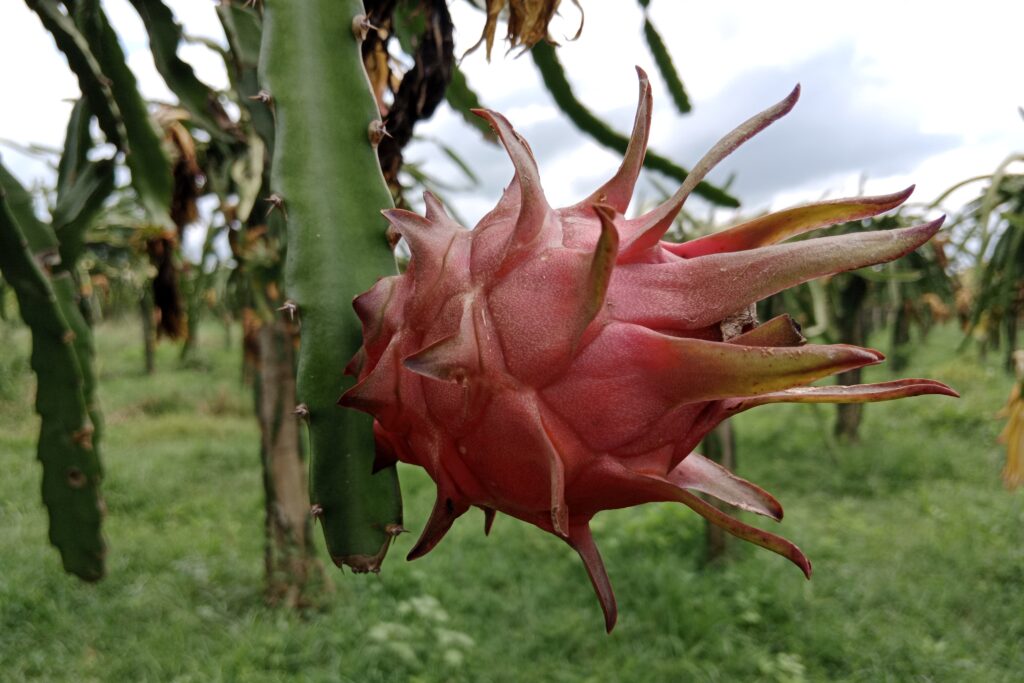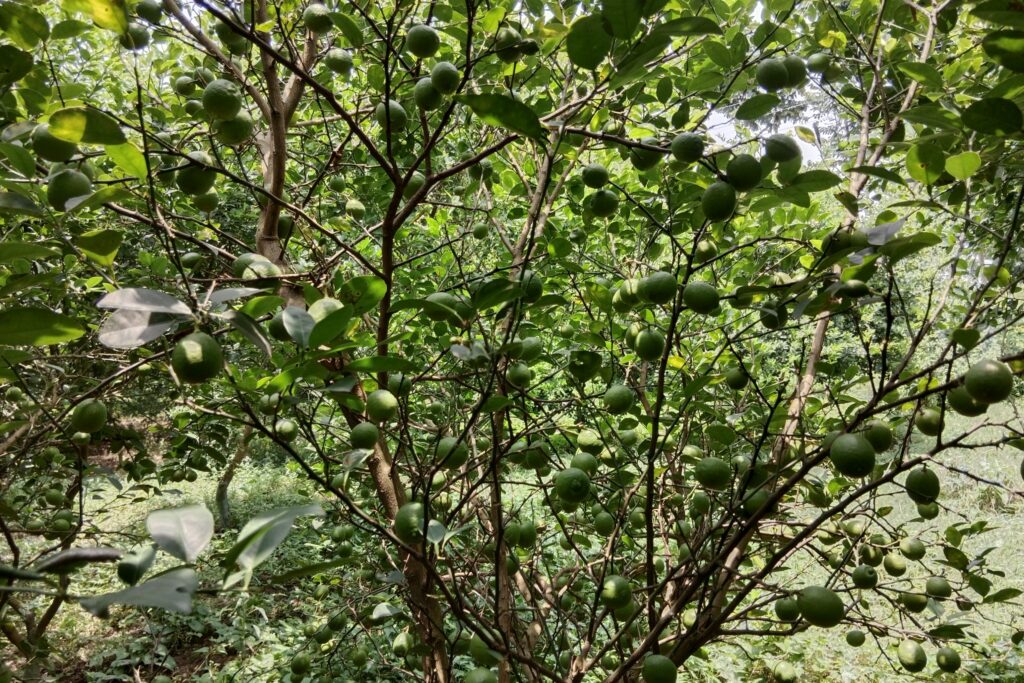Bamboo Shoot Farming
Bamboo shoot farming is an agroforestry practice focused on cultivating specific bamboo species for their edible young culms (shoots). It is a sustainable and profitable venture due to the high demand for shoots in fresh and processed forms, both domestically and internationally.
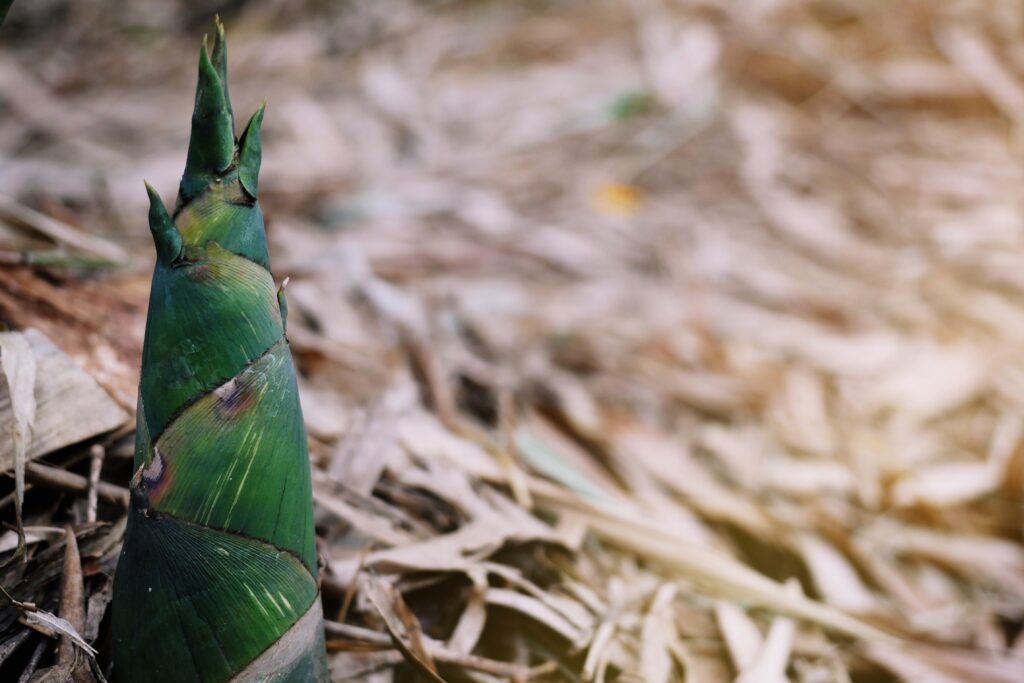
Bamboo shoot farming offers a highly profitable and sustainable agricultural enterprise, with initial years, particularly the 3rd year, potentially showing slight losses due to low yields, but profitability increasing rapidly from the 4th year onward.
Peak returns are typically achieved during years 6–10, driven by high yields and rising market prices. Over the long term, spanning 30 years, bamboo plantations provide a stable and lucrative income per acre, with net profits ranging from NRs. 26,800 to 151,600 annually after maintenance costs, making bamboo shoot farming profit per acre substantial, and considering the initial investment of NRs. 58,000, the plantation generally becomes fully profitable by the 4th year.
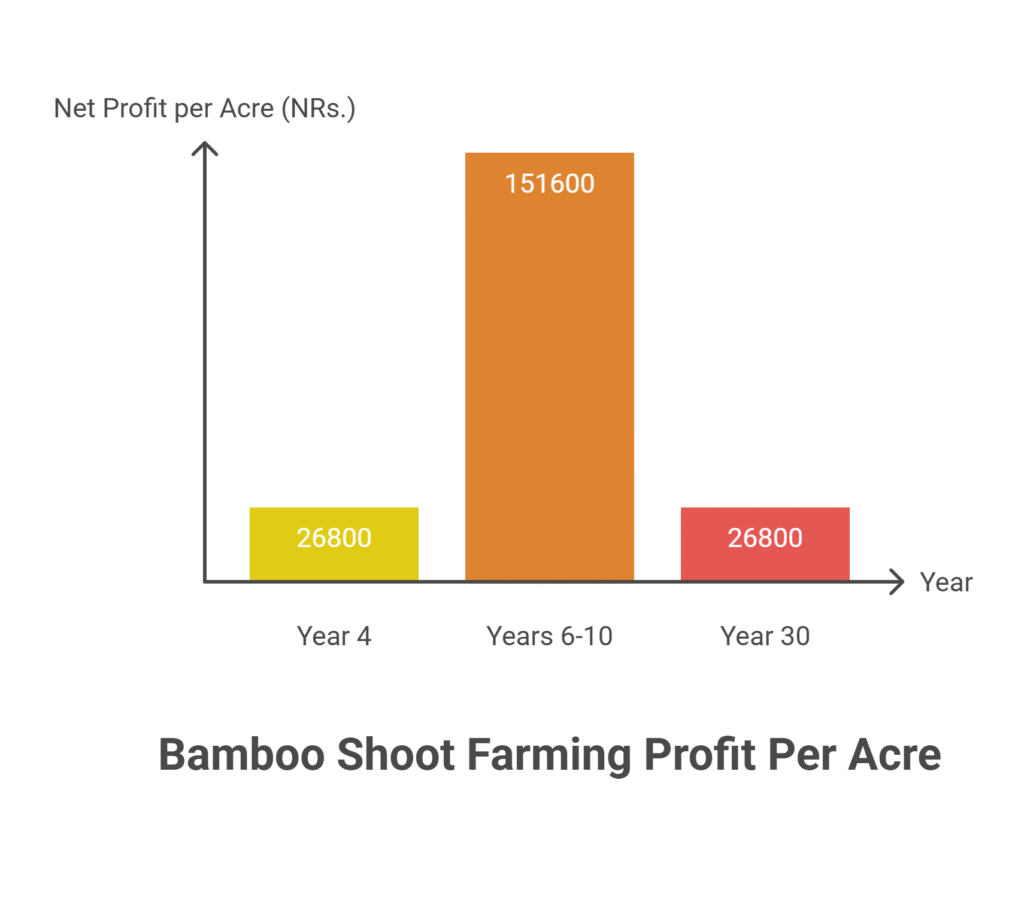
Land Preparation
Land preparation is a critical step in establishing a healthy and sustainable bamboo shoot plantation. The process begins with clearing the land of weeds, bushes, and tree stumps, ensuring that all perennial weeds are removed to minimize future competition. This is followed by deep plowing, usually up to 30–45 cm, carried out once or twice to break up compact soil layers, enhance aeration, and promote better root penetration.
Proper leveling of the field is equally important to ensure uniform water distribution and to prevent waterlogging in low-lying areas. Finally, depending on the chosen planting system—pit or trench—the field should be marked accordingly, and basins or trenches prepared at the recommended spacing for optimal bamboo growth.
Soil Type
Although bamboo is quite tolerant of several soil types, it thrives in deep, loamy, well-drained soils that are rich in organic matter. Its pH range is 5.5 to 7.0, which is slightly acidic to neutral. Heavy clay, poorly drained soils, or extremely alkaline soils are not ideal since they limit rhizome development and increase the risk of rot.
Climatic Requirements
The majority of edible bamboo species do best in warm, humid tropical to subtropical regions with temperatures between 15°C and 30°C. While they can tolerate the odd frost, extended freezing temperatures can seriously harm them. Bamboo needs steady moisture, especially when the shoots are emerging, thus a well-distributed yearly rainfall of 1200–2500 mm is optimal. The majority of commercial species are effectively grown from sea level up to roughly 1500 meters, though they are tolerant of varying elevations.
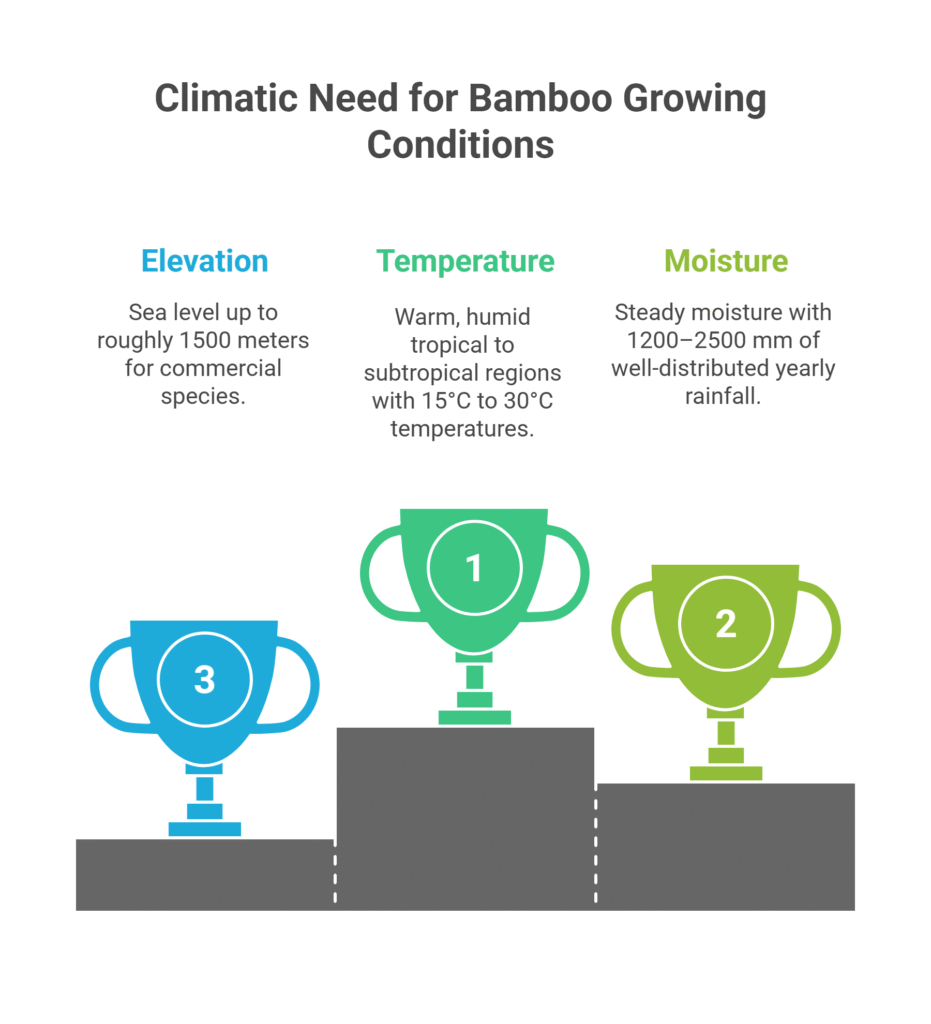
Major Cultivars (Species)
Climate adaptability, market demand, and intended use—whether for processing or fresh consumption—all have an impact on the choice of bamboo species. Among the most notable commercial species are:
| Species Name (Common Name) | Key Characteristics | Primary Use & Notes |
| Dendrocalamus asper (Giant Bamboo) | Large, thick-walled shoots. Sweet with minimal bitterness. | Commercial Canning. Considered one of the best species for processing. |
| Dendrocalamus brandisii | Produces high-quality, tender shoots. | Valued for its superior shoot quality. |
| Bambusa balcooa | Shoots are of medium quality. | Dual-Purpose (shoots & timber). Often consumed locally rather than commercially. |
| Phyllostachys edulis (Moso Bamboo) | The most important temperate species. Famous for its shoots. | Fresh Consumption / Processing. Requires a cooler climate to grow. |
| Bambusa vulgaris | Shoots are somewhat bitter. | Requires thorough boiling before consumption to remove bitterness. |
Propagation
Bamboo is primarily propagated vegetatively since seed production is rare and unpredictable. The most common and reliable method is rhizome or offset planting, where a 1–2-year-old culm with a healthy rhizome and roots is separated from the mother clump and planted directly in the field, ensuring genetic purity and quick establishment.
Another approach is macro-proliferation, which involves dividing a young clump into several propagules, each with a culm and rhizome. For large-scale, disease-free commercial cultivation, tissue culture is used, enabling rapid multiplication of elite cultivars but requiring advanced laboratory facilities.
Nursery Management
For effective nursery management in bamboo cultivation, a mother block of healthy, high-yielding, and disease-free clumps is maintained as the source of offsets. Offsets are carefully extracted to minimize damage to the rhizome and roots, then temporarily planted in polybags filled with a soil-sand-FYM mixture to promote new root growth and enhance survivability before being transplanted to the main field. The nursery should be maintained under partial shade with regular watering to ensure healthy seedling development.
Planting
a). Planting Season
The ideal planting season for bamboo is at the onset of the monsoon, typically in June–July, when abundant soil moisture promotes high survival rates and successful establishment.
b). Spacing
For optimal shoot production, wider spacing is recommended to allow rhizome expansion and facilitate easy harvesting, with a common spacing of 5m × 5m.
c). Pit Preparation
Prepare large planting pits measuring 60 cm × 60 cm × 60 cm, keeping the topsoil and subsoil separate for proper layering and soil fertility management.
d). Planting Method
For planting, fill each pit with a mixture of topsoil, 15–20 kg of well-decomposed Farmyard Manure (FYM), and 100 g of neem cake. Place the offset or polybag plant carefully in the center, ensuring the rhizome is positioned horizontally, with the root ball 5–10 cm below the soil surface. Fill the pit with the remaining soil mixture and press firmly to remove air pockets, promoting stable planting and healthy establishment.
e). Number of Plants per Acre
As per spacing, approximately 161 plants per acre.
Intercropping
Intercropping in bamboo plantations is highly beneficial, particularly during the first 2–3 years before the bamboo canopy closes. It helps suppress weeds, provides additional income, and enhances soil health. Suitable intercrops include legumes such as beans and groundnut, pulses, ginger, turmeric, and short-duration vegetables. Intercropping should be discontinued once the bamboo clumps mature and the canopy creates significant shade over the field.
Irrigation
Irrigation is essential for bamboo, especially during the first two years after planting and the shoot emergence season, which typically occurs in the dry summer months. Young plantations should be watered weekly during dry spells, while in mature plantations, irrigation immediately after shoot harvesting promotes the emergence of new shoots from the same bud. Drip irrigation is particularly effective, providing efficient and consistent moisture for optimal growth.
Fertilizer and Manure
Bamboo is a heavy feeder due to its rapid growth.
| Application Type | Recommended Dose & Composition | Timing / Notes |
| Basal Dose (At Planting) | 15-20 kg FYM (Farm Yard Manure) + 100g Neem cake per pit. | Applied once in the planting pit during initial setup. |
| Annual Application (Mature Clump: 4-5+ years) | Organic: 50-60 kg of FYM or compost per clump. Inorganic (per clump): • Nitrogen (N): 200-250g • Phosphorus (P₂O₅): 150-200g • Potassium (K₂O): 250-300g | Applied every year to support rapid growth. |
| Timing of Annual Application | Apply the full annual dose in two equal splits. | 1. First dose: At the beginning of the monsoon season. 2. Second dose: At the end of the monsoon season. |
Weed Control
Regular manual weeding or hoeing around the clumps, especially during the establishment phase, is an effective way to control weeds in bamboo plantations. Additionally, mulching the base with organic matter, such as dry leaves or straw, within a 1-2 m radius helps preserve soil moisture, inhibit weed growth, and improve soil fertility as it breaks down. Finally, pre-emergence herbicides, such as glyphosate, can be used for chemical control on pathways in a directed spray application that avoids the bamboo culms.
Interculture Operation
Intercultural operations in bamboo cultivation mainly involve training and pruning, where thinning is a crucial practice to manage mature clumps that become dense by annually removing old, dead, diseased, broken, and weak culms after the shooting season, thereby improving light and air penetration and encouraging the growth of new, healthy shoots, while earthing up the base of the clump with soil before the shooting season helps blanch the shoots, keeping them tender, less bitter, and easier to harvest.
Flowering Management
Bamboo flowering occurs gregariously at very long intervals of 30–120 years, during which the entire genetic cohort flowers simultaneously over large areas, and once flowering and seed setting are completed, the clump dies entirely; since no practical management practices can prevent this natural phenomenon, the only solution is to replant the area with new propagules obtained from non-flowering clumps after the flowering event.
Pest and Disease Management
Common Pests
Shoot Borer
The shoot borer larva bores into young bamboo shoots, reducing both quality and yield. Preventive management is the most effective approach. Regular earthing up around the clump helps protect emerging shoots, while prompt harvesting prevents larvae from establishing inside. Infested shoots should be destroyed immediately to break the pest cycle. For chemical management, spraying Quinalphos 25 EC @ 2 ml per liter of water or Chlorpyrifos 20 EC @ 2.5 ml per liter of water around the clump base during the shooting season can effectively reduce infestation.
Scale Insects and Mealybugs
These pests suck sap from bamboo culms and leaves, leading to yellowing, reduced vigor, and sometimes fungal sooty mold growth. Natural predators such as ladybird beetles can help in control. For chemical management, spraying Horticultural Mineral Oil (HMO) @ 1.5–2% solution is effective in smothering the pests. Alternatively, systemic insecticides such as Imidacloprid 17.8 SL @ 0.3 ml per liter of water or Thiamethoxam 25 WG @ 0.25 g per liter of water can be applied as foliar sprays to suppress heavy infestations.
Leaf Webbers and Defoliators
Leaf webbers and defoliators damage bamboo leaves by feeding on them, reducing photosynthesis and overall plant growth. Neem-based formulations are highly effective and eco-friendly, with Neem oil (Azadirachtin 3000 ppm) @ 5 ml per liter of water recommended as a foliar spray at 10–15 day intervals. For severe infestations, biological control agents such as Trichogramma parasitoids may be released, or selective insecticides like Lambda-cyhalothrin 5 EC @ 1 ml per liter of water can be applied to control larval populations.
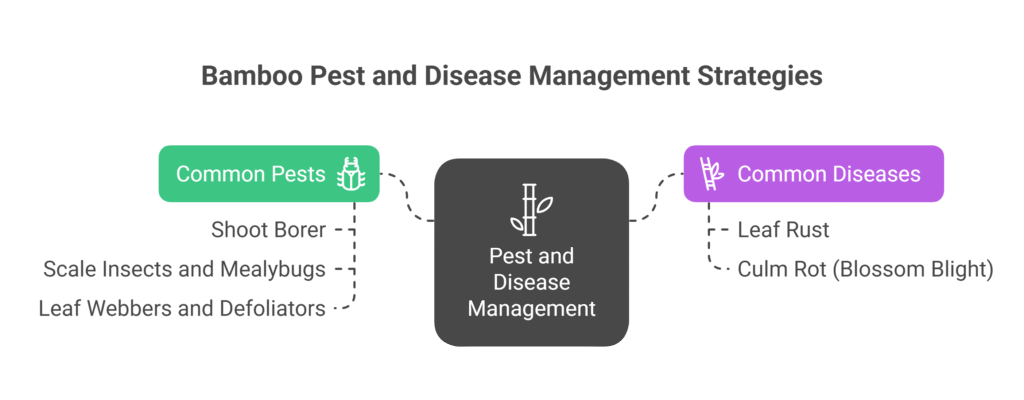
Common Diseases
Leaf Rust
Leaf rust is a common fungal disease in bamboo that appears as orange to reddish-brown pustules on the leaves. Severe infections reduce photosynthesis, weaken the plant, and lower productivity. Good management practices include thinning and pruning to improve air circulation around the clump, thereby reducing humidity that favors fungal growth.
For chemical control, fungicides such as Hexaconazole 5 EC @ 1 ml per liter of water or Propiconazole 25 EC @ 1 ml per liter of water can be sprayed at 15–20 day intervals during disease incidence. In organic management, Neem oil (Azadirachtin 3000 ppm) @ 5 ml per liter of water may be used as a preventive spray.
Culm Rot (Blossom Blight)
Culm rot, also known as blossom blight, is a fungal disease that mainly attacks young bamboo shoots, leading to soft rot, wilting, and eventual death if not managed. The disease is often aggravated by poor drainage, waterlogging, or physical injury to the shoots.
Cultural practices such as improving soil drainage, avoiding injury during harvesting, and removing infected culms promptly are essential. For chemical management, spraying Carbendazim 50 WP @ 1 g per liter of water or Mancozeb 75 WP @ 2.5 g per liter of water around the base of clumps and on affected shoots provides effective control. A combination fungicide like Carbendazim 12% + Mancozeb 63% WP @ 2 g per liter of water can also be applied for broad-spectrum protection.
Harvesting
Bamboo shoots are mostly harvested during the rainy season, and timing is critical as they must be collected when just emerging from the soil or only a few inches above ground, since they quickly become fibrous and bitter; the proper method involves carefully removing the soil around the shoot and cutting it from the point of attachment to the rhizome with a sharp spade or knife, ensuring the rhizome and nearby young buds remain undamaged, while in a well-managed plantation harvesting can be carried out every 3–4 days during the peak season.
Yield
Bamboo yield varies greatly depending on species, clump age, soil fertility, and management practices, with clumps beginning to produce commercially harvestable shoots from the 3rd or 4th year and reaching stabilized yields by the 5th year or later; a mature clump of a high-yielding species such as D. asper can produce 10–15 kg of shoots annually, and with a planting density of 160 clumps per acre, this translates to 1,600–2,400 kg (1.6–2.4 tonnes) of shoots per acre per year, while under exceptional management conditions yields may be even higher, with productivity increasing each year until clumps reach full maturity.
Cost of Investment per Acre for Bamboo Shoot Farming
| S.N. | Categories | Cost (NRs.) |
| 1 | Land Preparation | 15,000 |
| 2 | Planting Propagules (Seedlings) | 8,000 |
| 3 | Planting | 5,000 |
| 4 | Fertilizers and Manure | 10,000 |
| 5 | Irrigation | 7,000 |
| 6 | Weed Control | 5,000 |
| 7 | Pest & Disease Control | 3,000 |
| 8 | Miscellaneous Costs | 5,000 |
| Total Initial Investment | 58,000 |
Annual Maintenance Cost per Acre Per Year
The annual maintenance cost for bamboo shoot cultivation is approximately NRs. 50,000 per acre, which generally covers expenses for irrigation, fertilizer application, mulching, pest and disease management, weeding, pruning, harvesting labor, and routine field care, ensuring healthy clump growth, sustained yields, and long-term productivity of the plantation.
Income Per acre from Bamboo Shoot Farming annually
| Time Period | Estimated Yield (kg/acre) | Market Price (NRs./kg) | Annual Income (NRs.) |
| Year 3 | 640 | 60 | 38,400 |
| Year 4 | 1,280 | 60 | 76,800 |
| Year 5 | 2,400 | 60 | 144,000 |
| Years 6-10 | 2,880 | 70 | 201,600 |
| Years 11-20 | 2,400 | 80 | 192,000 |
| Years 21-30 | 1,920 | 100 | 192,000 |
Analysis of Bamboo Shoot Farming Profit Per Acre
Profit = Total Income – Annual Maintenance Cost
| Year | Total Income (NRs) | Maintenance Cost (NRs) | Net Profit (NRs) |
| 3rd Year | 38,400 | 50,000 | -11,600 |
| 4th Year | 76,800 | 50,000 | 26,800 |
| 5th Year | 144,000 | 50,000 | 94,000 |
| 6th–10th Year | 201,600 | 50,000 | 151,600 |
| 11th–20th Year | 192,000 | 50,000 | 142,000 |
| 21st–30th Year | 192,000 | 50,000 | 142,000 |
In bamboo shoot farming, the initial years, particularly the 3rd year, may show a slight loss due to low yields, but profitability rises rapidly from the 4th year onwards, reaching peak levels during years 6–10 because of high yields and increasing market prices; over the long term of 30 years, the plantation provides a stable and lucrative source of income per acre, with net profits ranging from NRs. 26,800 to 151,600 annually after maintenance costs and considering the initial investment of NRs. 58,000, the plantation becomes fully profitable by the 4th year.
Crop Calendar for Bamboo Shoot Farming
This calendar is designed for a species like Dendrocalamus asper in a climate with a distinct monsoon pattern (e.g., Nepal, Northern India). Timings may need slight adjustments based on your specific local climate and bamboo species.
| Period (Month) | Season | Key Activities | Description & Purpose |
| Feb – Mar | Late Winter / Early Summer | Pre-Emergence Preparation | • Earthing Up: Mound soil around the base of clumps to blanch upcoming shoots, keeping them tender and less bitter. • Irrigation: Begin regular irrigation if the soil is dry to trigger and support shoot emergence. |
| Apr – Jun | Summer / Pre-Monsoon | PEAK HARVESTING SEASON | • Harvesting: The primary shoot harvest occurs. Harvest every 3-4 days. Cut shoots at the rhizome connection point without damaging nearby buds. • Post-Harvest Irrigation: Water deeply after each harvest round to stimulate new shoot growth from the same bud. • Pest Monitoring: Intensively monitor for Shoot Borers. Destroy infested shoots immediately. |
| Jun – Jul | Onset of Monsoon | Planting & Major Fertilization | • Planting New Stock: The ideal time to plant new offsets or tissue culture plants. • First Split Application of Fertilizer: Apply the first half of the annual dose of FYM (25-30 kg/clump) and inorganic fertilizers (50% of N, P, K) as the monsoon begins. • Weed Control: Carry out manual weeding or apply pre-emergence herbicides on pathways after fertilization. |
| Jul – Sep | Monsoon | Growth & Maintenance | • Drainage Management: Ensure fields are not waterlogged to prevent culm rot. • Pest/Disease Control: Monitor for scale insects, mealybugs, and leaf rust. Apply neem-based solutions or recommended fungicides/insecticides if necessary. • Intercropping (if applicable): In young plantations (<3 yrs), manage intercrops. |
| Oct – Nov | Post-Monsoon / Autumn | Second Fertilization & Clump Management | • Second Split Application of Fertilizer: Apply the remaining half of the annual fertilizer dose. • Thinning & Pruning: After the shooting season, remove old, dead, diseased, and weak culms (3+ years old) to improve light and air penetration. This is a critical interculture operation. |
| Dec – Jan | Winter / Dormant Period | Harvesting (Minor) & Planning | • Minor Harvest: Some species may have a small, secondary harvest season. • Culm Harvesting: This is the ideal time to selectively harvest mature culms (3-5 years old) for timber, as the plant’s energy is in the rhizomes. • Planning & Maintenance: Repair irrigation systems, plan for the next season, and apply mulch to protect roots from cold. |
Sources
Food and Agriculture Organization (FAO)
University of California Agriculture & Natural Resources (UC ANR)
European Plant Protection Organization (EPPO)
Punjab Agricultural University (PAU)
Tamil Nadu Agriculture University (TNAU) – Agritech portal
Indian Council of Agricultural Research (ICAR)
Nepal Agricultural Research Council (NARC)
U.S. Department of Agriculture (USDA).
Ministry of Agriculture and Livestock Development (Nepal)
Disclaimer: This crop farming profits assume optimal conditions. Actual results may vary depending on climate, market prices, and farm management practices.

